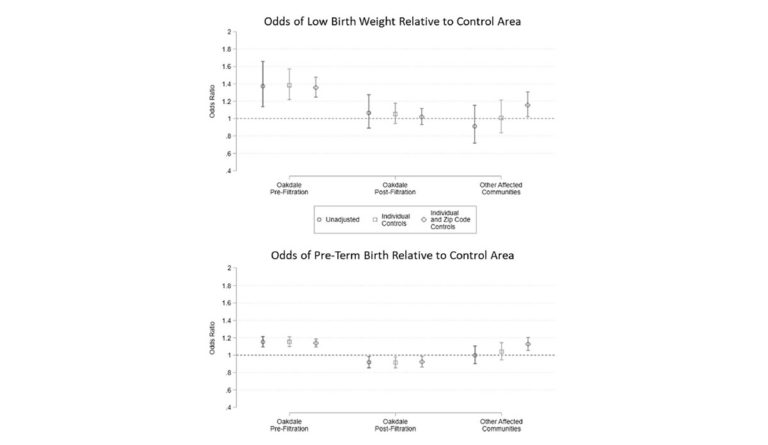One City’s Happy Ending
A team studied birth outcomes in Oakdale, Minnesota, before and after a 2006 water filtration facility was built to manage drinking water contaminated with high PFAS levels.

Read Time: 2 minutes
Published:
Non-stick pans. Water-repellent jackets. Fast food containers. What do these products have in common? They all likely contain per- and polyfluoroalkyl substances, otherwise known as PFAS. These synthetic chemical compounds, found in many consumer products, are hardy and can accumulate in the human body. Studies have associated high levels of PFAS with adverse birth outcomes, including low birth weight.
A team led by Gina Waterfield studied the town of Oakdale, Minnesota, where drinking water was contaminated with high levels of PFAS. A nearby industrial waste landfill was the cause of Oakdale’s unacceptably high concentrations. To lower PFAS back to safe levels, the city built a water filtration facility in 2006.
The researchers examined how the resulting decrease in PFAS levels from the water filtration affected birth outcomes among Oakdale residents. They analyzed birth record data from 2002-2011 (five years before the water filter was installed and five years after). They compared birth outcomes between babies born in Oakdale and babies born in neighboring communities with no detectable levels of PFAS.
The chances of an adverse birth outcome decreased significantly among Oakdale residents after the filtration system was installed. In the top chart, the three bars on the left illustrate that before filter installation, pregnant people in Oakdale had a higher likelihood of low birth weight infants compared to neighboring communities. The three bars in the middle of the top chart shows what happened after the water was filtered – the chances of low birthweight between babies born in Oakdale compared to surrounding areas became the same.
The bottom chart tells a similar story. Pre-filtration, pregnant people in Oakdale were more likely to have a pre-term birth, as shown by the three leftmost bars. The middle bars show that after filtration, pregnant people in Oakdale no longer had an increased risk for pre-term birth.
For children born after 2006, Oakdale’s story has a happy ending. But there are many more Oakdale’s across the country – cities and towns where residents are drinking PFAS-contaminated water. We know reducing PFAS to safe levels is attainable and critical for supporting reproductive health. But will municipal governments take action?
Waterfield G, Rogers M, Grandjean P, Auffhammer M, Sunding D. Reducing exposure to high levels of perfluorinated compounds in drinking water improves reproductive outcomes: evidence from an intervention in Minnesota. Environmental Health, April 2020.



